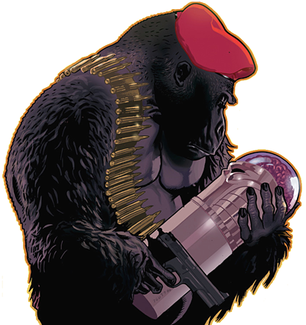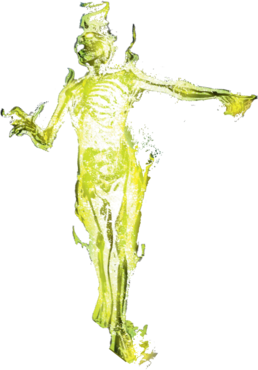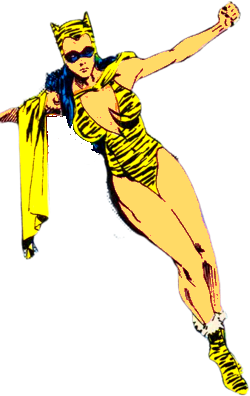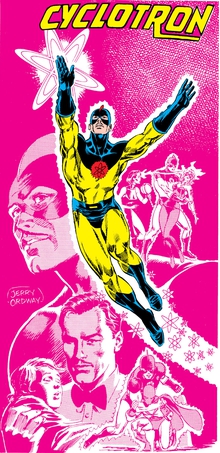
The Golden Age is a 1993 four-issue Elseworlds comic book mini-series by writer James Robinson and artist Paul Smith. It concerns the Golden Age DC Comics superheroes entering the 1950s and facing the advent of McCarthyism.

Ultra-Humanite is a supervillain appearing in American comic books published by DC Comics. He first appeared as a recurring adversary of Superman, and was among the first villains faced by him. He was designed to be the polar opposite of Superman; while Superman is a hero with superhuman strength, Ultra-Humanite is a criminal mastermind who has a crippled body but a highly advanced intellect. The Ultra-Humanite served as Superman's nemesis until Alexei Luthor and his Silver Age counterpart Lex Luthor were introduced in the comics. The origins of the super-criminal known as the Ultra-Humanite are shrouded in mystery. Even he claims not to remember his true name or appearance and attributes his vast intellect and mental prowess to scientific experiments of an unknown nature.
Miss America is a superheroine from the DC Comics Universe. She was first created by Quality Comics in Military Comics #1, and was carried over to DC Comics when they purchased Quality in the 1950s. While the original Golden Age character is in public domain, the subsequent versions created by DC Comics are not.

Rag Doll is the name of three different supervillains appearing in American comic books published by DC Comics. The first, Peter Merkel, is a villain of the original Flash, while the second is an enemy of Starman and the third is the son of the original and a member of the Secret Six.

The Brain is a supervillain appearing in American comic books published by DC Comics. Commonly as a frequent enemy of the Doom Patrol and the Teen Titans, he is a French genius and criminal mastermind.

Monsieur Mallah is a supervillain in the DC Comics Universe. He is the gorilla servant of and, in time, the partner to Gorilla Grodd and the Brain, while serving as an enemy of the Doom Patrol, Justice League, and the Teen Titans.

Icicle is the name of two supervillains appearing in comic books published by DC Comics: Joar Mahkent and Cameron Mahkent.

Doctor Phosphorus is a supervillain who has appeared in various comic book series published by DC Comics. Primarily an enemy of Batman, the villain exists in DC's main shared universe, known as the DC Universe.

Frankenstein is a fictional character appearing in American comic books published by DC Comics. He is based on the Frankenstein's monster character created by Mary Shelley.

The Creature Commandos are a fictional DC Comics team of military superhumans originally set in World War II. The original team was introduced in Weird War Tales #93, created by J. M. DeMatteis and Pat Broderick. The team was composed of a human team leader, a werewolf, a vampire, a Frankenstein's monster, and a gorgon.

The G.I. Robot is the name of a series of six fictional robots that appeared in comic books published by DC Comics. The first four G.I. Robot characters were all created by writer Robert Kanigher, though each was designed by a different artist. Each incarnation of the G.I. Robot is an android of advanced, experimental technology designed to carry out combat and rescue missions. Multiple versions of the G.I. Robot seem to develop their own free will, as well as loyalty and a sense of friendship towards human soldiers they work alongside.

Paula Brooks is a fictional comic book character published by DC Comics. She is one of many characters to use the names Tigress and Huntress. Paula Brooks is married to Sportsmaster and the mother of Artemis Crock.

Sylvester Pemberton, alternately known as The Star-Spangled Kid and Skyman, is a superhero in the DC Comics universe. Sylvester first appeared in Star Spangled Comics #1 and was created by Jerry Siegel and Hal Sherman.

Johnny Quick is a Golden Age DC Comics character with the power of superhuman speed. The character first appeared in More Fun Comics #71. After his More Fun run ended in issue #107, he was moved to Adventure Comics with issue #103. He remained as a regular feature in Adventure until issue #207.

Cyclotron is the name of two different characters appearing in American comic books published by DC Comics. Though a minor character, he holds an important place in the history of the Justice Society as a source of power and inspiration for both the Atom and Atom Smasher.

The War that Time Forgot is a comic book feature published by DC Comics beginning in 1960 in the title Star Spangled War Stories, created by Robert Kanigher, Ross Andru and Mike Esposito. It ran for eight years, ending in 1968 and returned as a limited series in 2008.
Captain Compass is a character in the DC Comics universe first appearing in 1948 in an issue of Star Spangled Comics, as a replacement for the original Robotman strip.
Brain Wave is a supervillain appearing in the DC Comics Universe, a recurring foe of the Justice Society of America and a founding member of the Injustice Society; he is also the father of the superhero Brainwave.














